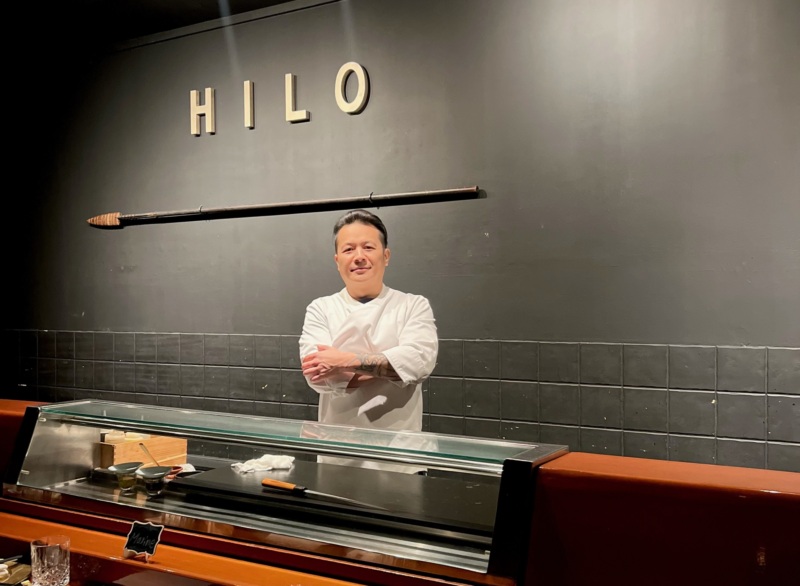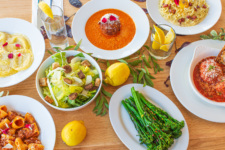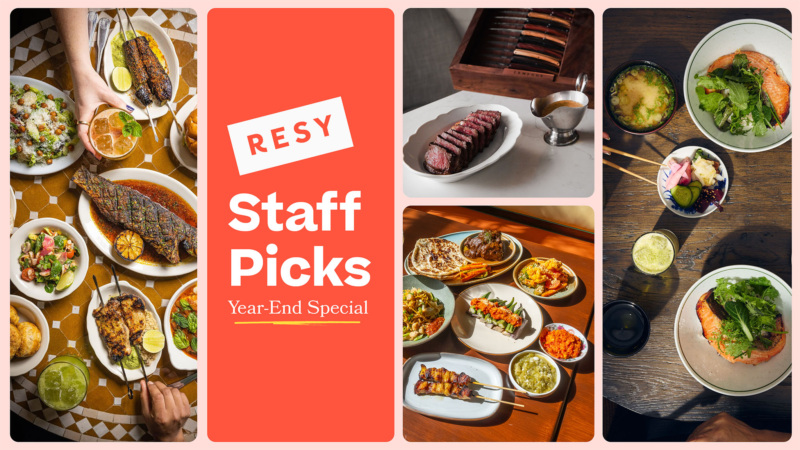
Hilo Mahenola Thinks You Should Eat More Omakase
Hilo Omakase’s opening in the summer of 2022 could hardly be called auspicious. After what seemed like a smooth passing of the guard, the new owner of the storefront on South Beverly Drive, Hilo Mahenola, found himself with the phone line cut and a business stripped of everything that was promised to him: plates, table settings, even the toilet paper in the bathroom.
A year and a half later, any traces of Hilo Beverly Hills’ bumpy first days are long gone. The omakase restaurant’s walls have been painted jet black, table tops are covered in white linen, and a sharp spear made of koa wood hangs on the wall behind the chef’s station: a symbol of Mahenola’s Native Hawaiian heritage and a reminder of his roots in Hana, Maui, where he grew up. Hilo himself is a showman, comfortable charming the entire restaurant with the sort of twinkle rarely seen outside of a magic act.
Lunch and dinner, served Tuesday through Sunday, is a show of a different kind. Dazzling oyster shooters, laid over ice on the half shell, come adorned with masago caviar, quail eggs, and a citrus ponzu sauce made in-house. Cuts rarely seen in high-end sushi restaurants in Los Angeles, like Hawaiian amberjack and kahala (the latter, also known as Almaco jack, arrives laced with a particularly delightful Italian summer black truffle), are placed strategically amongst albacore sashimi, tuna tartare, and other familiar crowd favorites. Everything can be paired with wine or sake; wasabi is always freshly grated. The Yuki Tsubaki grain used in every dish has been called “the world’s finest Koshihikari rice.” And the water, both for drinking and cooking, is always at a perfect 8.5 pH. Simply put, excellence here is no accident.
Resy recently sat down with Mahenola to discuss his unique approach to Japanese cooking, how his previous experience at the Fish House in Encino informs his work now, and why omakase restaurants aren’t just for special occasions.


You’re Native Hawaiian and grew up on Maui. How does your upbringing influence the way you approach sushi today?
As a chef, you need to understand the culture. For me, having a strong Hawaiian and Japanese background became a really deep foundation. It’s not just the cooking but what you represent. What’s the law of sushi? What’s the law of Japanese food? What’s the philosophy behind it? [My background] has forced me to understand my culture in order to present the food.
The principle behind Japanese food is good ingredients and timing; eating clean and eating healthy. This is us. This is who we are. I’m just speaking for myself — I want to stick with those traditions, so I don’t do fusion. It’s [already] a good piece of fish, so my task becomes elevating it to another thing, adding something onto it to give it a little more personality.
In what ways has the restaurant changed since opening in 2022? You mentioned that transferring ownership was difficult, but have there been other challenges?
That was just a little hiccup. And it made me a better chef. When I moved to Beverly Hills, I think I was expecting a challenge. I was coming from running a successful restaurant in the Valley, where I felt like I had no more room to grow. I was willing to get out of my comfort zone to be here. Uncomfortable, I think that’s the right word for me to say. I like being uncomfortable.
Talk about your approach to the menu.
I created a menu that is original for me. Because I’m not one of those [people] who takes something from the menu of every single other restaurant. Oh, I like this idea. I like this idea. I’m sure that every bite you have, you for sure haven’t tasted anywhere else.
At dinner, I use toro as the opening dish, with Beluga sturgeon caviar. It’s a very strong opening. My philosophy is: you want the first dish to make people stop talking, no matter if there’s four or nine people sitting in front of you. The restaurant industry is so different now. Back then, it was all about the taste. Now, the camera always eats first. But with the first dish, people aren’t busy taking pictures.
What makes your approach to omakase special?
The most important thing is: you cannot break the rule of structure. Food should be served from light to heavy. You can’t be all over the place. That’s the hard part. Every single thing in the restaurant has a story behind it. For an omakase chef, everything is about the details. The water that I serve, the wasabi on the plate, the glasses that I use. The sake cups are made of tin and plated gold. You can feel it, its heaviness. Why? Everything for me is why, everything has to have a why, an intention.


You have quite the impressive sake collection — how did you put it together?
First, you have to do your homework. This is what I want. This is the direction. I worked with a French sommelier and the number one sake sommelier in America for three months. I invited them to try my omakase, from start to finish. They tasted it, and took some notes. Then, they started giving comments. Chef, this is better, or this is better. They even tried to change the course of the food! At one point, between the sake and wine, we drank maybe 200 bottles.
When you want to build something, you have to put your ego aside. If you think you know everything, you don’t. It’s good to seek someone out that knows more. You have to remind yourself: I know nothing.
Do you feel inspired by other sushi restaurants in Los Angeles?
Oh, absolutely. Every chef in L.A. inspires me. Sometimes, they teach me what not to do [laughs]. But mostly, they show me what I should do even more of. I believe chefs should live in community. We are not singular. You know, healthy encouragement, competing with only yourself, respect. Those things are important to me. Chefs can do well together: rise up and raise all the boats together.
I think that’s a healthy way of looking at it. How do you see Hilo Omakase fitting into, not only Los Angeles right now, but the larger pantheon of L.A. sushi restaurants?
The way I see things is, the omakase experience is individual to each establishment. There’s no wrong or right. At some restaurants, it’s quiet and people don’t want to talk. And that’s what some people like. But other people want someone like me, an individual without an investor, a chef who is focused on the food, humanity, and the experience. I want to be the chef of the people. I want people to come back. When you get to this level in restaurants, you may only see your clientèle once or twice a year.
I want to be the chef of the people. I want people to come back.— Hilo Mahenola
Because it’s a special occasion.
Yes, but that’s not how I wish it was. I want people to come back often because it’s memorable, and not just for the food. What does it mean to be a chef? You learned how to make 12 pieces of sushi at a restaurant, does that mean you’re a chef? No. The Spanish have a phrase, menu de dia. It means “today’s menu.” This is what I have. This is what you get. And you pay this price, no substitute. You don’t like it, I don’t care. That’s not what omakase is about. It’s a customized menu for every person. Maybe you don’t like shellfish. Maybe you’re allergic to oysters, or don’t like sea urchin. Okay, yes, it’s a little more work, a bit harder to cater to many people. But that’s what chefs do.
We talked about how the restaurant’s evolved since opening in 2022. The decor’s changed, you’ve added several omakase options, and started serving lunch. What do you envision for Hilo Beverly Hills in 2024 and beyond?
I’ve always had one goal: Become a place that people must go to, a destination restaurant. I’m creating a different experience. Everyone is important to me. If you took two hours, or an hour and a half out of your life, with your significant other, or co-worker, or business leader, or just yourself, you chose this restaurant to escape from the busy world. That’s the experience I want to create.
Kat Hong is a food writer living in Los Angeles. Follow her on Instagram, Twitter/X, or Bluesky, or check out her very professional website. While you’re at it, follow Resy, too.
Discover More

Stephen Satterfield's Corner Table



















